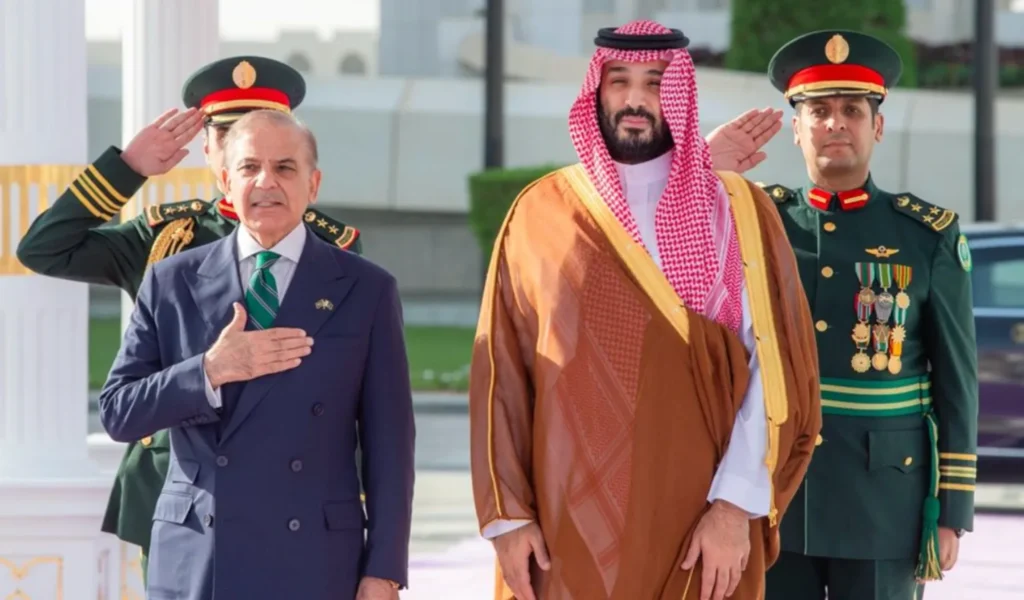
A Historic Agreement with Global Implications
On 17 September 2025, Saudi Arabia and Pakistan signed the Strategic Mutual Defense Agreement (SMDA) in Riyadh, marking one of the most significant military alignments in recent Middle Eastern history. The agreement declares that any aggression against either country will be treated as aggression against both, while also establishing new frameworks for military coordination, joint training, and defense cooperation.
The pact has attracted global attention because it pairs Saudi Arabia’s financial muscle with Pakistan’s extensive military capabilities, including its status as the only nuclear-armed Muslim-majority nation. While nuclear weapons were not mentioned in the official text, the symbolism has been strong enough to trigger speculation about whether Riyadh has effectively gained a “nuclear umbrella.”
What the Pact Includes – and What It Doesn’t
Pakistani Defense Minister Khawaja Mohammad Asif has emphasized that nuclear weapons are “not on the radar” of this agreement. At the same time, his remarks that Pakistan’s nuclear program “will be made available” to Saudi Arabia if necessary marked the first public hint at extending nuclear deterrence beyond South Asia.
Saudi officials, for their part, have called the deal a “comprehensive defensive arrangement”, without confirming or denying whether nuclear deterrence forms part of the pact. Analysts note that this ambiguity itself may be part of the strategy, signaling deterrence without triggering formal escalation.
Key confirmed elements include:
- Joint training and defense planning
- Expanded intelligence sharing
- Broader cooperation on conventional military assets
- A mutual defense clause comparable in tone, if not in detail, to NATO’s Article 5

Why the Pact Matters Now
Several converging factors explain why Saudi Arabia and Pakistan formalized this agreement in 2025:
- Escalating Regional Tensions: Israeli airstrikes in Qatar and the continued war in Gaza have heightened Gulf states’ sense of vulnerability. The pact is viewed as a direct response to these perceived threats.
- Declining U.S. Credibility: For decades, Gulf nations relied on American security guarantees. But recent shifts in U.S. foreign policy and perceptions of disengagement have pushed Riyadh to seek alternatives.
- Historical Bonds: Saudi Arabia has long been one of Pakistan’s key financial supporters, offering loans and aid in times of crisis. Pakistan, in turn, has maintained military contingents in Saudi Arabia for decades. The pact formalizes this enduring relationship.
Global and Regional Reactions
- Israel and Iran: Israel, widely believed to be the only nuclear power in the Middle East, has not commented publicly. Analysts believe Israel will closely watch whether the pact alters the strategic balance. Iran, already under pressure over its own nuclear program, is expected to view the pact with suspicion.
- India: India has stated it will “study the implications” of the agreement for its own security and for global stability. With India and Pakistan locked in a historic rivalry and both nuclear-armed, any sign that Pakistan’s arsenal could be extended beyond South Asia raises concern in New Delhi.
- United States: Washington has not issued detailed commentary, but observers note that the pact reflects growing doubts in the Gulf about the reliability of U.S. security commitments.
What the Pact Does Not Guarantee
Despite the intense debate, certain realities remain clear:
- The pact does not contain any explicit nuclear sharing clause.
- Pakistan has not altered its official doctrine, which remains focused on deterring India.
- Saudi Arabia describes the agreement as defensive only, not a framework for offensive action.
- No operational mechanisms for nuclear coordination have been disclosed.
This means that while the symbolism of a Saudi nuclear umbrella looms large, the practical implementation remains uncertain.
Strategic Significance for Both Sides
For Saudi Arabia, the agreement reduces dependence on Western security guarantees and provides a credible deterrent against regional rivals. It also positions Riyadh as a leader in shaping a new Middle Eastern security architecture.
For Pakistan, the pact offers financial and diplomatic benefits while expanding its influence beyond South Asia. Analysts say the deal may provide Islamabad with new leverage in its long-running strategic competition with India.
At the same time, the agreement inserts Pakistan into a volatile geopolitical environment, potentially complicating its already delicate foreign policy balancing act.
Key Questions Moving Forward
- Will the pact extend to other Gulf nations? Reports suggest the agreement may eventually cover broader regional defense.
- How will nuclear deterrence be managed? Without clarity, speculation about command and control mechanisms will continue.
- How will rivals respond? India, Iran, and Israel are all recalculating in light of the pact.
- What about non-proliferation? Pakistan is not a signatory to the Nuclear Non-Proliferation Treaty (NPT), raising concerns among global watchdogs.
A New Security Chapter
The Saudi–Pakistan Strategic Mutual Defense Agreement is not just another bilateral treaty; it represents a shift in the region’s power equations. For Saudi Arabia, it is a hedge against both Iran and Israel, and a signal of independence from U.S. reliance. For Pakistan, it is a chance to project power in the Middle East while gaining economic reinforcement.
Yet the lack of clarity on nuclear provisions leaves as many questions as answers. Until more details emerge, the pact should be seen less as a dramatic shift in nuclear posture and more as a strategic recalibration that underscores shifting alliances in the Middle East.
Final Word
This agreement, while defensive on paper, could redefine deterrence in the Gulf for years to come. By binding together Saudi Arabia’s resources and Pakistan’s military muscle, Riyadh and Islamabad have created a partnership that regional and global powers cannot ignore.
Whether this becomes a stabilizing factor or sparks further rivalries will depend on how transparently the two nations manage the pact—and how responsibly they handle the nuclear undertones that now hang over Middle Eastern security.






